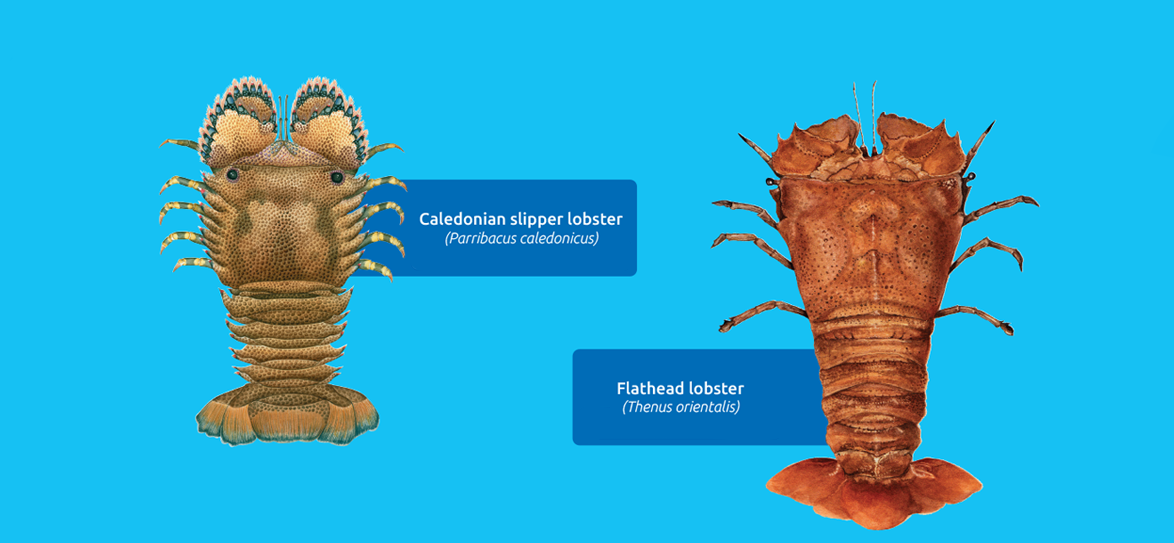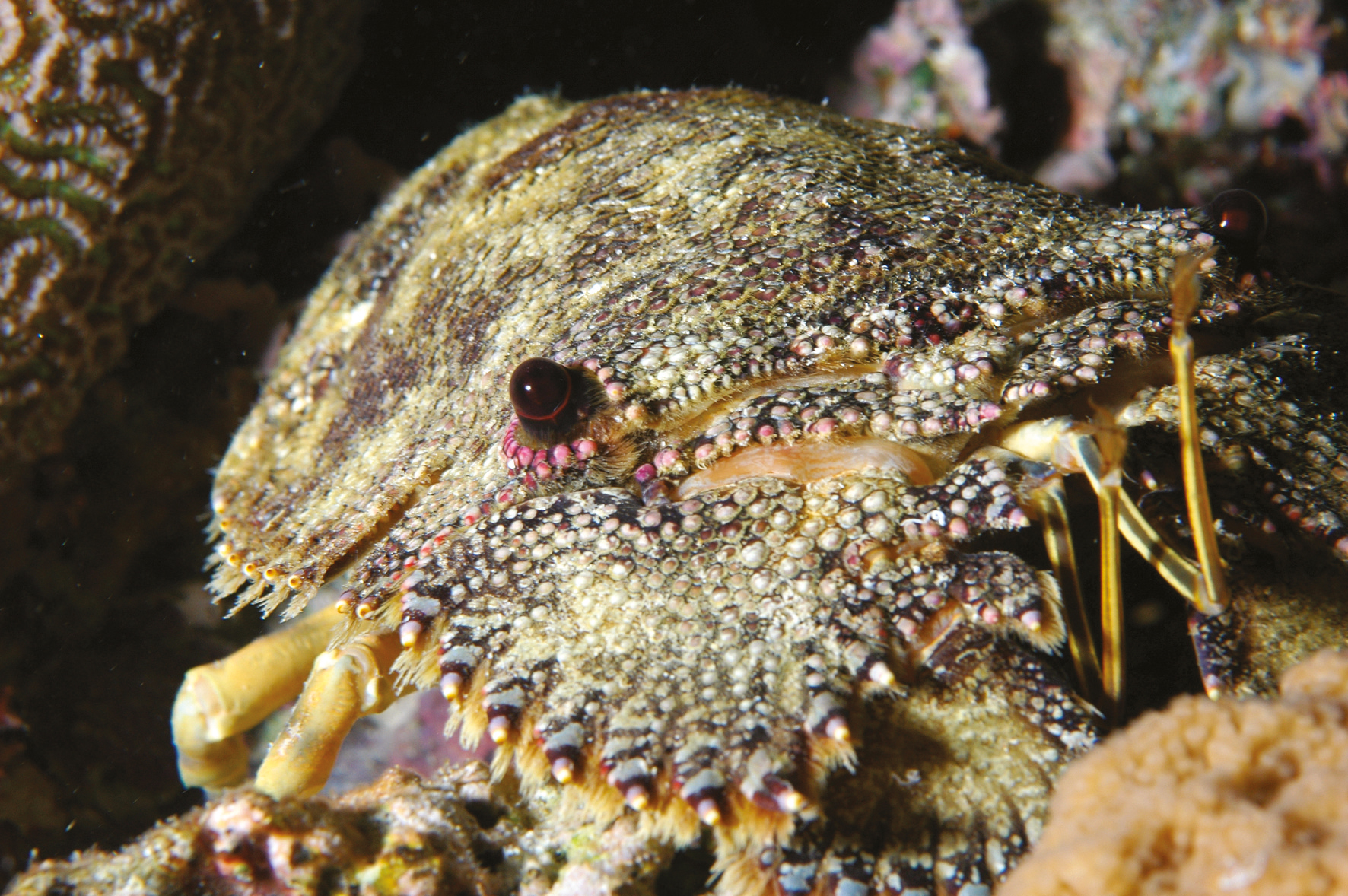Image: © Matthieu Juncker
To gain access to full information on slipper lobsters, download the information sheet produced by the LMMA Network and SPC.
If you have noticed a decline in your catches or are concerned about slipper lobster populations, here are some priority actions the community can consider in addition to national regulations:
Fish smart rules
Gear restrictions
Ban the use of underwater breathing apparatus. This method of collection, often associated with commercial fishing, may remove all mature slipper lobsters from an area.


Fishing bans
Ban the catching of small slipper lobsters. Enforce national minimum size limits if declared; if not, set community size limits based on the same species in nearby countries (use the SPC booklet as a guide).
Ban the catching of slipper lobsters carrying eggs. Female slipper lobsters carry easily visible eggs beneath their bodies. However, this control may be of little use if slipper lobsters are speared.
Ban the export of slipper lobsters. Although this measure is usually a national one, some communities on small islands have banned the export of lobsters to protect their fishery and to attract tourists.
Tabu areas
Rotate the catching of lobsters on different areas of reef. Each area could be fished for one year and then left unfished for a number of years; at least three unfished years would be needed to allow juveniles to grow to maturity.


Temporary bans
Ban fishing during the spawning season. The time of egg-bearing may be known to local fishers. If not, observe catches throughout the year and ban fishing for a month or more after females with eggs are first seen.
Quotas
Apply local catch limits. Bag limits, or catch quotas, may be appropriate if local people are catching slipper lobsters to sell. A catch limit may be set, for example, at 10 slipper lobsters per person per day.

Good to know: neighbouring communities should enforce the same management measures for slipper lobsters
The small larval stages of slipper lobsters drift in the sea for a very long time before settling as juveniles on reefs, often some distance away. This means that an individual community’s actions to manage its slipper lobster fishery may not benefit its own fishers. The best solution is for neighbouring communities along a coastline to work together and agree to take the same management measures.
Fishing methods
Slipper lobsters that prefer sandy sea floors, such as Thenus are often caught by trawling or by setting baited traps. Those that prefer reefs (including Parribacus species) are usually caught at night by hand or by divers, sometimes with underwater breathing apparatus, using spears.
Management measures in the region
Fisheries authorities in several Pacific islands have applied minimum size limits on various slipper lobsters. Minimum sizes for various species can be found on the Reeflex online portal, by selecting size limits (in ‘select regulations’) and filtering by species.
Some authorities have banned the taking of soft-shelled slipper lobsters and egg-bearing females. French Polynesia has imposed a closed season (1 November–31 January) presumably to protect breeding slipper lobsters.
Some species

The crustaceans commonly known as slipper, shovel-nosed or mitten lobsters are related to spiny lobsters (information sheet 13) but have flattened bodies.
Several species are caught as food in Pacific islands and only a representative few are described here. These include the Caledonian slipper or mitten lobster, Parribacus caledonicus, which grows to a total length of 180 millimetres and is distributed widely in the western Pacific Ocean.
The Hawaiian or sculptured slipper lobster, Parribacus antarcticus, is found in all oceans including the South Pacific Ocean and reaches a size of 200 millimetres.
The flathead lobster, Thenus orientalis, is distributed in the Indian and Pacific oceans and grows to a length of 280 millimetres and a weight of over 0.5 kg.
Slipper lobsters are bottom dwellers and live in the shallow water of lagoons and in crevices on reefs. Many species hunt at night and burrow in sand or hide on reefs during daylight. Some, such as the Caledonian mitten lobster, live in cavities or nests with small openings.
Slipper lobsters eat a variety of molluscs, including limpets, mussels and oysters as well as small shrimps, crabs, worms and sea urchins. Their predators include triggerfish, groupers and octopuses.
Slipper lobsters have separate sexes and reach reproductive maturity at about 3 years of age.
During mating, a male deposits a sperm packet (or spermatophore) on the underside of a female. The female releases up to 100,000 eggs which she carries beneath her body for 2 weeks or more as they develop and change in colour from orange to brown. The eggs hatch into very small floating larval stages which drift in the sea for up to 11 months - less than one in every thousand survives to settle on the sea floor to become a juvenile slipper lobster. And less than one in every hundred juveniles survives to become a mature adult, possibly living for 10 years.
Related resources

To gain access to full information on slipper lobsters, download the information sheet.
